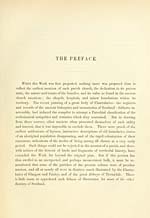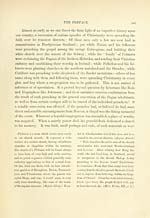Bannatyne Club > Origines parochiales Scotiae > Volume 1
(26) Page xx
Download files
Complete book:
Individual page:
Thumbnail gallery: Grid view | List view

THE PREFACE.
In a glance at the origin and history of our parochial sj'stem, it may be
convenieut to use the term Parish as meaning a district appropriated to one
baptismal church, though it was not employed in its present restricted sense in
the early ages of the Church either among us or in the other countries of
Christendom.^
1 Parish — parochia — va^omia, — meaning
any district, was at first appropriated to
the diocese of a bishop. In 1179 it is used as
synonymous with diocesis, and applied to the
Bishopric of Glasgow. {Regist. Glasff., pp. 43,
50, 55.) In some instances it would seem to
mean the jurisdiction rather than the district.
KingWilliam the Lion in a charter to the monks
of Kelso, speaks of the waste of Selekyrcke
to which he had transferred his men of Eire-
hope, as being ' of the parish of his vil of
Selechirk.' {Liber de Calchou, p. 16.) But
the term soon began in Scotland to be applied,
though not technically and exclusively, to the
baptismal church territory. In the middle of
the 12th century Herbert bishop of Glasgow
confirmed to the monks of Kelso the church of
Molle, which Uctred the son of Liulf gave
them, with the lands and parishes and all
rights belonging to that church. {Liber de
Calchou, p. 820.) Before the middle of the
following century the parish of Molle seems to
have been territorially defined, and in a con-
troversy between Melrose and Kelso concern-
ing it in 1269, the words parish and parish-
ioners {parochia et parochiam) are used much
in their present sense. {Ibid., p. 146.) In the
year 1220 the churches belonging to the Abbey
of Jedburgh are termed parishes {parochie),
and the church of Jedburgh is styled parochi-
alis ecclesia. {Regist. Glasg., p. 97-) Abbot
Ailred in describing the successful preaching of
Saint Ninian among the Picts of Galloway —
the crowding to his baptism of ricli and poor,
young and old, renouncing Satan and joining
the army of the faithful — represents him as or-
daining priests, consecrating bishops, and con-
ferring the other dignities of ecclesiastical
orders, and finally dividing the whole land into
parishes — totam terram per certas parochias
ditidere, {apud Pinkerton Vit. Sanct. Scot., p.
11.) It is scarcely necessary to remark that
Ailred in speaking of the acts of Saint Ninian
uses the language of his own time. Indeed that
life is of little value, written in rhetorical style,
and bearing few marks of being compiled from
ancient materials. Bede spe.aks more correctly,
when he says of Saint Cedd that he erected
churches in many places {fecit per loca eccle-
sias), and ordained priests and deacons to
assist him in preaching the faith and adminis-
tering baptism. {Hist. Eccles., lib. iii., c. 22.)
The word shire {schira, scyra) so common
in our older church records, is often equivalent
to parish, but sometimes applies to some
other ' division ' of church territory which we
cannot now define. The divisions of North
Durham were Islandshire, Norliamshire, and
Bedlingtonshire. In the Merse we had Colding-
hamschire ; in Clydesdale, Machanshire, Kil-
brideshire ; in Fife, the shires of Kilrimund
(Saint Andrews) Forgrund, Futhrif, Karel,
Kinnahin, Kennocher, Kinninmond, Kircala-
dinit (Kirkaldy), Gelland, and Gateniilc ;
in Aberdeen, Clatshire and the sliires of Tuly-
nestyn, Kane, and Davyot.
In a glance at the origin and history of our parochial sj'stem, it may be
convenieut to use the term Parish as meaning a district appropriated to one
baptismal church, though it was not employed in its present restricted sense in
the early ages of the Church either among us or in the other countries of
Christendom.^
1 Parish — parochia — va^omia, — meaning
any district, was at first appropriated to
the diocese of a bishop. In 1179 it is used as
synonymous with diocesis, and applied to the
Bishopric of Glasgow. {Regist. Glasff., pp. 43,
50, 55.) In some instances it would seem to
mean the jurisdiction rather than the district.
KingWilliam the Lion in a charter to the monks
of Kelso, speaks of the waste of Selekyrcke
to which he had transferred his men of Eire-
hope, as being ' of the parish of his vil of
Selechirk.' {Liber de Calchou, p. 16.) But
the term soon began in Scotland to be applied,
though not technically and exclusively, to the
baptismal church territory. In the middle of
the 12th century Herbert bishop of Glasgow
confirmed to the monks of Kelso the church of
Molle, which Uctred the son of Liulf gave
them, with the lands and parishes and all
rights belonging to that church. {Liber de
Calchou, p. 820.) Before the middle of the
following century the parish of Molle seems to
have been territorially defined, and in a con-
troversy between Melrose and Kelso concern-
ing it in 1269, the words parish and parish-
ioners {parochia et parochiam) are used much
in their present sense. {Ibid., p. 146.) In the
year 1220 the churches belonging to the Abbey
of Jedburgh are termed parishes {parochie),
and the church of Jedburgh is styled parochi-
alis ecclesia. {Regist. Glasg., p. 97-) Abbot
Ailred in describing the successful preaching of
Saint Ninian among the Picts of Galloway —
the crowding to his baptism of ricli and poor,
young and old, renouncing Satan and joining
the army of the faithful — represents him as or-
daining priests, consecrating bishops, and con-
ferring the other dignities of ecclesiastical
orders, and finally dividing the whole land into
parishes — totam terram per certas parochias
ditidere, {apud Pinkerton Vit. Sanct. Scot., p.
11.) It is scarcely necessary to remark that
Ailred in speaking of the acts of Saint Ninian
uses the language of his own time. Indeed that
life is of little value, written in rhetorical style,
and bearing few marks of being compiled from
ancient materials. Bede spe.aks more correctly,
when he says of Saint Cedd that he erected
churches in many places {fecit per loca eccle-
sias), and ordained priests and deacons to
assist him in preaching the faith and adminis-
tering baptism. {Hist. Eccles., lib. iii., c. 22.)
The word shire {schira, scyra) so common
in our older church records, is often equivalent
to parish, but sometimes applies to some
other ' division ' of church territory which we
cannot now define. The divisions of North
Durham were Islandshire, Norliamshire, and
Bedlingtonshire. In the Merse we had Colding-
hamschire ; in Clydesdale, Machanshire, Kil-
brideshire ; in Fife, the shires of Kilrimund
(Saint Andrews) Forgrund, Futhrif, Karel,
Kinnahin, Kennocher, Kinninmond, Kircala-
dinit (Kirkaldy), Gelland, and Gateniilc ;
in Aberdeen, Clatshire and the sliires of Tuly-
nestyn, Kane, and Davyot.
Set display mode to: Large image | Transcription
Images and transcriptions on this page, including medium image downloads, may be used under the Creative Commons Attribution 4.0 International Licence unless otherwise stated. ![]()
| Publications by Scottish clubs > Bannatyne Club > Origines parochiales Scotiae > Volume 1 > (26) Page xx |
|---|
| Permanent URL | https://digital.nls.uk/81023296 |
|---|
| Description | Volume first. Diocese of Glasgow. |
|---|---|
| Shelfmark | SCS.BC.97 |
| Additional NLS resources: | |
| Attribution and copyright: |
|
| Description | Place of publication Edinburgh unless otherwise stated. No. 125 is relative to but not part of the club's series. |
|---|---|

